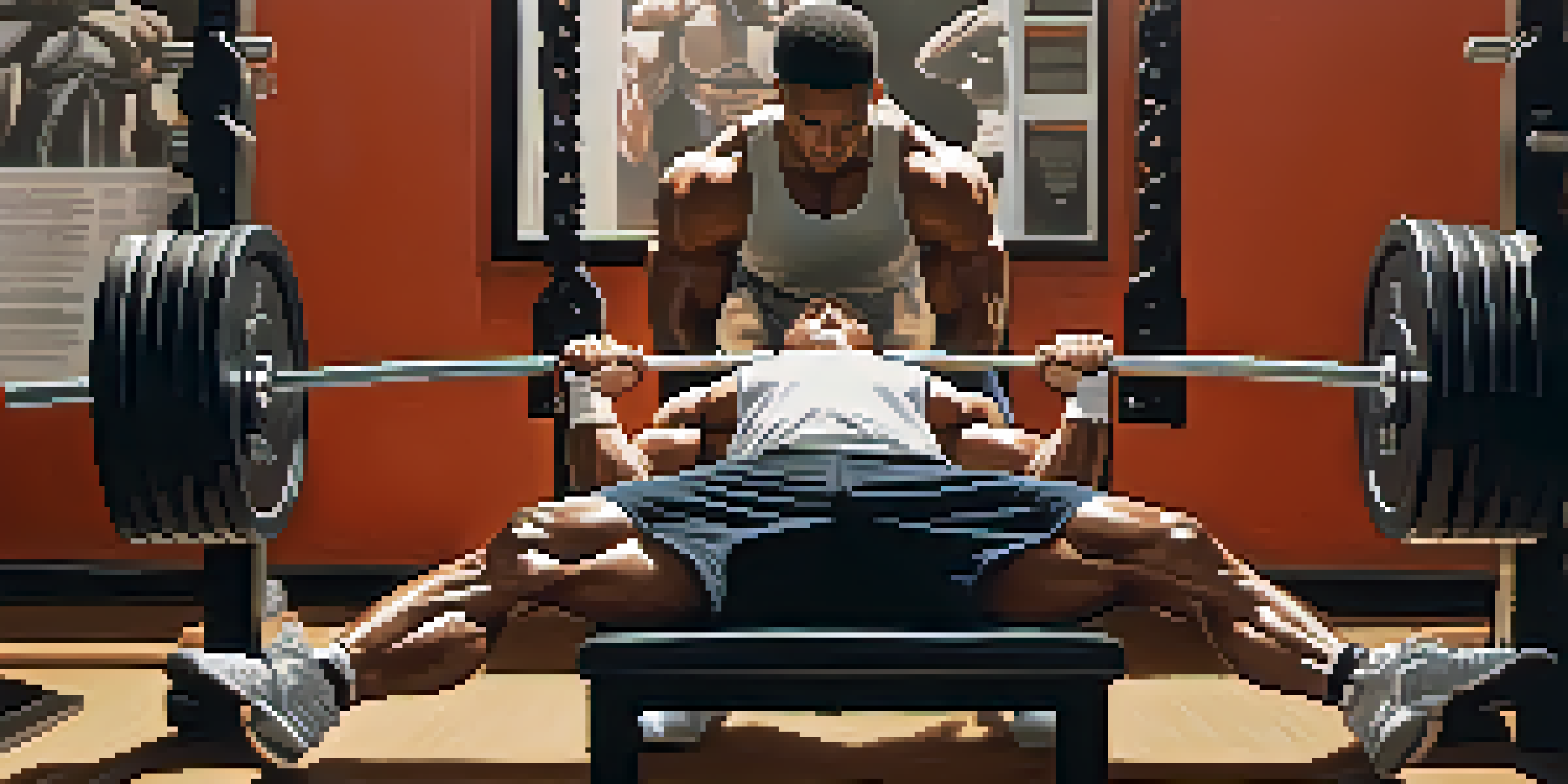Bench Press Techniques for Upper Body Injury Rehabilitation

Understanding Upper Body Injuries and Rehabilitation
Upper body injuries can stem from various activities, from sports to daily tasks. These injuries often impact the shoulders, chest, and arms, making rehabilitation essential for recovery. Understanding the nature of these injuries helps tailor effective rehabilitation strategies that include strength training, stability exercises, and proper techniques.
The greatest glory in living lies not in never falling, but in rising every time we fall.
Rehabilitation aims to restore function and strength while preventing future injuries. It's crucial to identify the specific injury type, whether it's a strain, sprain, or tear, as this knowledge directs the recovery process. Engaging in a structured rehabilitation program can significantly enhance recovery outcomes and improve overall performance.
Bench press techniques can play a key role in rehabilitation by helping rebuild strength and stability in the upper body. However, modifying these techniques to accommodate injuries is vital. With the right approach, individuals can safely return to their favorite activities while minimizing the risk of re-injury.
The Importance of Proper Form in Rehabilitation
Proper form in bench pressing is crucial, especially during rehabilitation. Using the correct form reduces the risk of exacerbating an existing injury and ensures that the right muscle groups are targeted. It’s like following a recipe; if you skip steps or add ingredients incorrectly, the final dish may not turn out as expected.

When performing the bench press, focus on maintaining a neutral spine, keeping your feet flat on the ground, and ensuring that your wrists are aligned with your elbows. These small details can make a big difference in your rehabilitation journey. Additionally, using a spotter can provide extra safety and support as you work on regaining strength.
Rehabilitation Requires Proper Form
Maintaining proper form during exercises like the bench press is essential to prevent further injuries and ensure effective recovery.
Taking the time to master proper bench press form can lead to better results and a more enjoyable workout experience. As you progress, reinforcing good habits will help prevent injuries from recurring, allowing you to lift with confidence once again.
Adjusting Weight and Resistance for Safe Rehab
When returning to the bench press after an injury, it's essential to adjust the weight and resistance to suit your current strength level. Starting with lighter weights allows you to regain confidence while focusing on proper form. Gradually increasing resistance as your strength improves can help you avoid setbacks during recovery.
Strength does not come from physical capacity. It comes from an indomitable will.
Using resistance bands or lighter dumbbells can be effective alternatives to traditional weights. These tools allow for controlled movements that can help you build strength without overloading your recovering muscles. Think of it as easing into a warm bath—too much heat at once can be overwhelming, but a gradual increase feels just right.
Listening to your body is key during this process. If you experience discomfort or pain while lifting, it’s a sign to reassess your approach. Remember, the goal is to rebuild strength safely, so prioritize quality over quantity in your training.
Incorporating Variations for Targeted Muscle Recovery
Incorporating bench press variations can target specific muscle groups, which is beneficial for recovery. For instance, incline or decline bench presses can shift the emphasis between different parts of the chest and shoulders, allowing for a more tailored rehabilitation approach. These variations can enhance muscle activation and promote balanced strength development.
Another effective variation is the dumbbell bench press, which allows for a greater range of motion and can help improve stability in the shoulder joint. This flexibility is particularly helpful during rehabilitation, as it encourages the use of stabilizing muscles that may have weakened during the injury period. Think of it like diversifying your investments; different exercises can yield better overall results.
Adjust Weight Gradually for Safety
Starting with lighter weights and gradually increasing resistance helps to rebuild strength safely while minimizing the risk of re-injury.
Experimenting with various bench press techniques can keep your workouts fresh and engaging. As you explore these alternatives, you’ll discover which movements feel best for your body and contribute most to your recovery.
The Role of Mobility and Flexibility in Recovery
Mobility and flexibility are often overlooked components of rehabilitation, yet they play a critical role in recovery. Maintaining and improving flexibility in the shoulders, chest, and back can enhance your range of motion and overall performance. Think of flexibility as the oil that keeps the engine running smoothly; without it, things can get stiff and uncomfortable.
Incorporating stretching and mobility exercises into your routine can help alleviate tension and improve your ability to perform bench presses safely. Simple movements like shoulder dislocates with a resistance band or chest openers can make a noticeable difference in your recovery. Consistency is key; even a few minutes of stretching each day can yield significant benefits.
By prioritizing mobility alongside strength training, you create a balanced approach to rehabilitation that supports long-term health. As you regain strength, don’t forget to keep working on flexibility to ensure you maintain a full range of motion.
Listening to Your Body and Progressing Gradually
One of the most important aspects of rehabilitation is learning to listen to your body. It’s easy to get excited about returning to your pre-injury strength levels, but rushing the process can lead to setbacks. Just like a sprinter pacing themselves during a race, it’s essential to find a steady rhythm that allows for gradual progress.
Pay attention to how your body responds to various exercises and weights. If something feels off or uncomfortable, don’t hesitate to adjust your routine. Keeping a training journal can be beneficial in tracking your progress and noting any discomfort, creating a clearer path toward recovery.
Consult Professionals for Guidance
Working with a physical therapist or trainer can provide personalized strategies and support, enhancing the rehabilitation process.
Remember, recovery is not a race but a journey. Celebrate small victories, like completing a set with proper form or increasing your weight slightly. Each step forward is a testament to your hard work and dedication.
Consulting Professionals for Optimal Rehabilitation
Consulting with a physical therapist or a certified trainer can greatly enhance your rehabilitation experience. These professionals can provide personalized guidance tailored to your specific injury and recovery goals. They have the expertise to help you navigate the complexities of rehabilitation, ensuring you’re on the right track.
A professional can also assess your technique and make recommendations for modifications or alternative exercises. This support can be invaluable, especially if you’re unsure about how to progress safely. Think of them as your GPS on the road to recovery; they can help you avoid detours and arrive at your destination more efficiently.

Ultimately, working alongside professionals can instill confidence and accountability, making the rehabilitation process smoother. Don’t hesitate to seek help; investing in your recovery can lead to better outcomes and a quicker return to your regular routine.